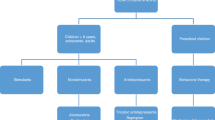Abstract
Attention-deficit hyperactivity disorder (ADHD) is highly prevalent in children and adolescents. Highly effective pharmacological treatments are available that allow the child and the adolescent to function at his/her full potential. Various preparations of methylphenidate and amphetamines have been used for a long time in the treatment of ADHD. This article reviews these and some of the newer drugs used in the treatment of ADHD, including atomoxetine and bupropion.
Similar content being viewed by others
References
Greydanus DE, Sloane MA, Rappley MD. Psychopharmacology of ADHD in adolescents.Adolesc Med 2002; 13: 599–624.
Greydanus DE, Pratt HD, Sloane MAet al. Attention-deficit/ hyperactivity disorder in Children and adolescents: Interventions for a complex costly clinical conundrum.Pediatr Clin North Am 2003; 50: 1049–1092.
Greydanus DE. Psychopharmacology of ADHD in adolescents: Quo vadis?Psychiatr Times 2003; 20: 5–9.
National Institute of Mental Health (NIMH).Attention Deficit Hyperactivity Disorder. NIMH, NIH Publication No. 01-4589, 2001. Available at: http://www.nimh.nih.gov/publicat/ helpchild.cfm.
National Institute of Mental Health.NIMH Research on Treatment for Attention Deficit Hyperactivity Disorder (ADHD): The Multimodal Treatment Study—Questions and Answers. Washington, DC: NIMH, 2000. Available at:http://www.nimh.nih.gov/events/mtaqa.cfm
National Institute of Health (NIH).Diagnosis and Treatment of Attention Deficit Hyperactivity Disorder. NIH Consensus Statement Online 1998: Nov 16–18; [cited year, month, day]; 16(2): 1–37.
Pratt HD. Neurodevelopmental Issues in the assessment and treatment of deficits in attention, cognition, and learning during adolescence.Adolesc Med 2002; 13(3): 579–598.
Reiff MI, Stein MT. ADHD evaluation and diagnosis: A practical approach to office practice.Pediatr Clin North Am 2003; 50: 1019–1048.
Staufer WB, Greydanus DE. Attention-devicit/hyperactivity disorder psychopharmacology for college students.Pediatr Clin North Am 2005; 52: 71–84.
Wolraich ML, Wibbelsman CJ, Brown TE. ADHD: A review.Pediatrics 2005; 115: 749–757.
The International Classification of Diseases, 10th ed. (ICD-10), WHO, 1993.
American Psychiatric Association.Diagnostic and Statistical Manual of Mental Disorders, 4th edn., Text Revision. Washington, DC: Author, 2000; 85–93.
Wolraich ML, Felice ME.The Classification of Child and Adolescent Mental Diagnoses in Primary Care: Diagnostic and Statistical Manual for Primary Care (DSM-PC): Child and Adolescent Version. Elk Grove Village, IL; American Academy of Pediatrics, 1986, 93–110.
Barkley RA. Attention-deficit/hyperactivity disorder. Sci Am 1998; 66–71.
Barkley RA, ed.Attention Deficit Hyperactivity Disorder: A Handbook for Diagnosis, 2d edn. New York; Guilford Press, 1998.
Stein MT. ADHD: The diagnostic process from different perspectives.Dev Behav Pediatr 2004; 25: 53–57.
Cunningham CF. A large-group, community-based, family systems approach to parent training. In: Barkley RA, ed.Attention Deficit Hyperactivity Disorder: A Handbook for Diagnosis, 2d ed. New York: Guilford Press, 1998.
Swanson JM and MTA Cooperative Group. National Institute of Mental Health Multimodal Treatment Study of ADHD Follow-up: Changes in effectiveness and growth after the end of treatment.Pediatrics 2004; 113: 762–769.
Whalen CK, Henker B. Therapies for hyperactive children: Comparisons, combinations, and compromises.J Consult Clin Psychol 1991; 59(1): 126–137.
Bradley C. The behavior of children receiving benzedrine.Am J Psychiatry 1937; 94: 577–585.
Clarke SD. ADHD in adolescence.J Adolesc Health 2000; 127: 77–78.
Pliszka SR, Greenhill LL, Crismon MLet al. The Texas children’s medication algorithm project: report of the texas consensus conference panel on medication treatment of childhood, attention-deficit/hyperactivity disorder. Part I.J Am Acad Child Adolesc Psychiatry 2001; 39: 908–919.
Rappley MD. ADHD.N Engl J Med 2005; 352: 123–125.
Schubiner H, Robin AL, Young J. Attention-deficit/ hyperactivity disorder in adolescent males.Adolesc Med 2003; 14: 663–676.
Wender EH. Managing stimulant medication for attention-deficit/hyperactivity disorder: An update.Pediatr Rev 2002; 23: 234–236.
Jensen PS, Hinshaw SP, Swanson JM, Greenhill LL, Conners CKet al. Findings from the NIMH Multimodal Treatment Study of ADHD (MTA): Implications and applications for primary care providers.J Dev Behav Pediatr 2001; 22: 60–73.
Solanto MV, Arnsten AFT, Castellanos FX. The neuroscience of stimulant drug action in ADHD. In Solanto MV, Arnsten AFT, Castellanos FX, eds.Stimulant Drugs and ADHD. London; Oxford University Press, 2001; 355–379.
Varley C: Sudden death of a child treated with imipramine.J Child Adolesc Psychopharmacol 2000; 10: 321–325.
Varley CK. Sudden death related to selected tricyclic antidepressants in children: Epidemiology, mechanisms and clinical implications.Paediatr Drugs 2001; 3: 613–627.
Atomoxerine: Strattera revisited.Med Lett 2004; 46 : 65.
Author information
Authors and Affiliations
Corresponding author
Rights and permissions
About this article
Cite this article
Greydanus, D.E. Pharmacologic treatment of attention-deficit hyperactivity disorder. Indian J Pediatr 72, 953–960 (2005). https://doi.org/10.1007/BF02731672
Issue Date:
DOI: https://doi.org/10.1007/BF02731672




